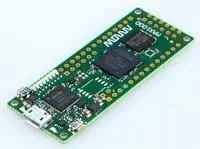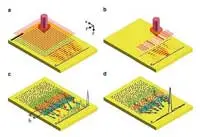Electronics News
Archive : 25 March 2017 год
 Global distributor Arrow Electronics is making available a FPGA IoT Maker Board. Designed for end-to-end application development and optimised for cost, the MAX1000 board can be installed directly into a custom application or integrated on to a separate board
Global distributor Arrow Electronics is making available a FPGA IoT Maker Board. Designed for end-to-end application development and optimised for cost, the MAX1000 board can be installed directly into a custom application or integrated on to a separate board
Intended for use by start-ups, universities or established equipment manufacturers who looking for a flexible, low cost FPGA platform for development, customised variants of the board are also available, according to Arrow.
The MAX1000 board can be installed directly into a custom application or integrated on to a completely separate board and is intended for use by start-ups, universities or established equipment manufacturers who looking for a flexible, low cost FPGA platform for development. Customised variants of the board are also available, according to Arrow.
At the board’s heart is a compact (11 x 11mm) Intel MAX10 FPGA with 8000 logic elements. This chip includes integrated flash memory, a 1Msample/s 12bit A/D converter for analogue signals and a 3.3V power supply. Other features include embedded SRAM, DSP blocks, instant-on within milliseconds, and the ability to implement Intel’s NIOS II soft core embedded processor to perform microcontroller tasks.
The board is equipped with an integrated Arrow USB-Blaster meaning that the FPGA can be programmed directly from a PC and debugged using the free of charge Intel Quartus Prime Lite software. As a result the MAX1000 is an easy to use plug and play solution. The USB-Blaster can also be integrated into the user’s own circuit if required.
The board’s power can be supplied as 5V from the USB port or via a separate pin. An Enpirion DC/DC converter with integrated coil then generates the 3.3V supply used on board. A MEMS oscillator provides the clock supply for the FPGA and the USB bridge. The low power, three axis acceleration sensor, which is also based on MEMS technology, can be used for position and motion detection, which are often required in IoT applications.
External SDRAM can be used for storage of application data or as memory for the NIOS II processor.
To provide an easy introduction into the use of FPGAs, a series of demo projects with NIOS II soft IP controllers are provided with the MAX1000. Eight configurable LEDs are available to display status and user inputs can be made via two buttons. A two-row connector, based on the Arduino MKR standard, and a PMOD plug provide flexible connectivity options including the ability to attach adaptor boards for wireless ICs or sensors.
Author
Neil Tyler
Source: www.newelectronics.co.uk
 A research group from Korea’s Institute of Basic Science has devised a disordered arrangement for antennas, which is said to minimise redundancy and to enable each antenna to function independently. As a result, the device is said to provide 40 times wider bandwidth than periodically arranged antennas.
A research group from Korea’s Institute of Basic Science has devised a disordered arrangement for antennas, which is said to minimise redundancy and to enable each antenna to function independently. As a result, the device is said to provide 40 times wider bandwidth than periodically arranged antennas.
"We are proposing a new way to connect nanoscale microprocessors to high-speed optical communications," commented Dr Wonjun Choi.
Due to technical limitations, the processing speed of semiconductors has remained at several gigahertz for the past decade. To counter this, many MCUs are used in parallel, but the electrical connection between the processors is slow. To solve this problem, many studies have been conducted to merge processors by using optical signals.
The team used surface plasmons to mediate optoelectronic signalling. At nano antennas, optical signals are converted to surface plasmons, which then propagate through the metal surface as electric signals. The researchers randomly arranged the nano antennas, and the surface plasmons generated at each antenna underwent multiple scattering to minimise redundancy between the antennas.
In this way, each antenna could be used independently, resulting in a substantial increase in the effective number of antennas. This increases the number of multiple input channels in the MIMO communication, which leads to an increase in the information transmission bandwidth.
“We proved that we can transmit signals to six different microprocessors at the same time and proved that optical images are converted into plasmons,” concluded Dr Choi.
Author
Peggy Lee
Source: www.newelectronics.co.uk
